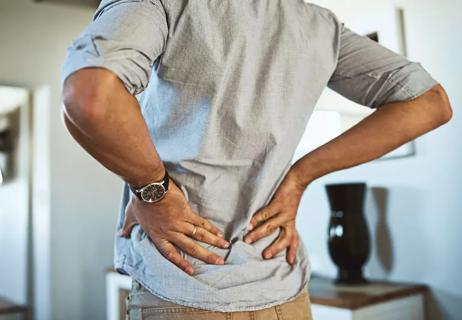Taking precautions and working smartly can keep aches and soreness away

Yards cover millions of acres around our houses ― and many of us fixate on making every inch look perfect. That’s fabulous for the appearance of our lawns and gardens. It’s often not so great for how our backs feel.
Advertisement
Cleveland Clinic is a non-profit academic medical center. Advertising on our site helps support our mission. We do not endorse non-Cleveland Clinic products or services. Policy
Hours of yard work can leave you with a painful reminder of what it took to get the job done. But know this, too: Back pain isn’t a curse that comes with having a green thumb.
How we tackle our chores typically contributes to the hurt we experience afterward. We can put unnecessary strain on our backs just by the way we shovel mulch or yank out pesky weeds.
So, we asked chiropractor Andrew Bang, DC, for tips to help our backs feel as good as our yards look after a day of working outside.
You might not think of it this way, but puttering around the yard qualifies as a workout.
An hour of light gardening or yard work burns about 330 calories per hour, according to the U.S. Centers for Disease Control and Prevention (CDC). That’s more than activities such as bicycling (290 calories), walking (280 calories) or a light weightlifting workout (220 calories).
(Calorie calculations are for a person weighing 154 pounds/70 kilograms. The calorie burn would be higher for those weighing more and lower for those weighing less.)
“Working in the yard comes with physical demands,” says Dr. Bang. “Think about what you do out there. You’re lifting, twisting, leaning, kneeling, crouching, squatting ― all actions that ask a lot of your muscles and joints.”
Advertisement
Many of us aren’t used to those movements either, given jobs and lifestyle habits that are increasingly sedentary.
So, when you transform into a weekend yard warrior, it might leave your body feeling achy.
“You’re suddenly doing a task repetitively without the conditioning for it,” he explains. “It’s no different from deciding to go on a long bike ride for the first time in a year. That can make you feel sore.”
Back pain is the most common complaint following a day of getting dirty in the yard. But you may be able to avoid that soreness by following these tips.
Would you hop right into a gym workout cold? Probably not. Take that same principle out into the yard. It can be as easy as doing a few stretches and taking a quick surveillance lap around the lawn.
“Just try to get your blood flowing and loosen up tight muscles before you jump right into a project,” recommends Dr. Bang.
Body mechanics are important as you shovel dirt, rake up leaves or pull weeds. Keeping your back in a more upright position helps prevent unnecessary stress on your spine.
“Your spine is shaped like an S for a very specific reason,” Dr. Bang says. “It’s a spring, essentially, and as gravity is bearing down, that S shape helps disperse force throughout your spine. That keeps one disk or one vertebra from taking on too much pressure.”
But if you hunch over, that flattens the natural curves in your spine and focuses weight on single disks or vertebrae, primarily in your lower back. “That’s when your problems start,” he notes.
It’s best to keep movements smooth and avoid any sudden twisting or reaching motions, too.
One of the best ways to keep back pain at bay is to break up your work routine. “We get in trouble when we decide to weed the garden and then try to do the whole garden at once,” says Dr. Bang.
He recommends doing one job for 20 minutes and then switching to another task for a bit. That avoids the aches and pains that come from holding one position for too long.
Again, he compares the thought process to working out: “You wouldn’t think of going to the gym and spending an hour on the same exercise machine,” he says. “So, why do that in the yard?”
The right tool can minimize wear and tear on your back as you take care of business around the yard. That includes:
Advertisement
Consider wearing a back brace or support if you know you’re in for a long day of yard work. “They can help you maintain good posture and keep too much pressure from building on your back,” says Dr. Bang.
Your body will let you know when it’s being overworked. So, if your back starts to ache while doing a project in the yard, take it as a sign to stop for the day. Don’t push through pain to get the job done.
And if you’re feeling a bit achy after a day of landscaping, try to work it out instead of just crashing on the couch for the night.
“Do some walking or stretching,” advises Dr. Bang. “Movement will help reduce some of that delayed soreness that often starts to creep in later. Motion is lotion, and it will help with the healing.”
Advertisement
Learn more about our editorial process.
Advertisement

When your lower back hurts, stretching and staying active can be key to finding relief

A physical therapist answers your questions

Manual therapy offers relief without the unwanted side effects of medication

Find relief by keeping a neutral spine, trying a medium-firm mattress and using pillows for support

Hanging upside down for any length of time may decompress the tension in your spine

Stretches, exercises and posture changes can help address lower cross syndrome

Drinking alcohol can cause nerve pain, dehydration and weight gain, which can all lead to back pain

Your sleep position, immobility, mattress and underlying conditions can all cause morning back pain

Start having sex about 72 hours before ovulation, then at least every other day during your fertile window

Attachment theory suggests that your earliest relationships shape connections throughout your life

It isn’t a recognized mental health disorder, but research shows that problematic social media use can negatively affect your mental health, self-esteem and sleep